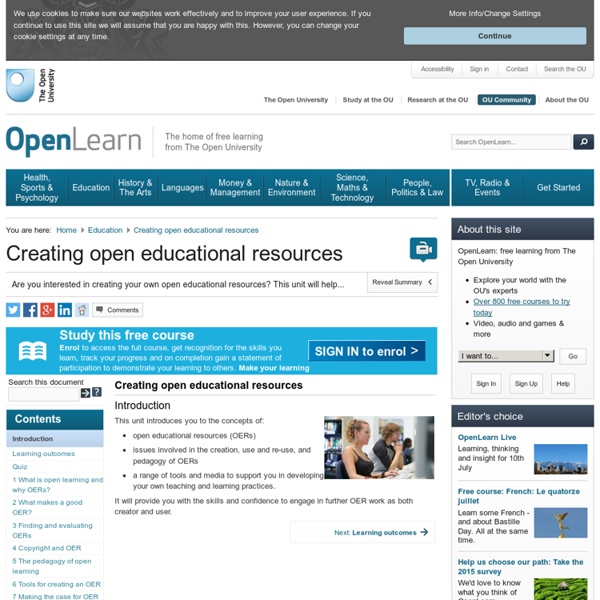



» OER15 The Design Studio / Welcome to the Design Studio Find OER | Open Professionals Education Network CC licensed (BY) Flickr photo shared by David Amsler modified by Paul Stacey Reusing existing Open Educational Resources (OER) can save significant time and effort. The OPEN partners recommend TAACCCT grantees invest up-front time finding OER to reuse rather than starting development of new educational resources right away. A significant benefit of OER is that they provide source material to build your development efforts around. No need to invest development effort in creating something that already exists. OER come in a wide variety of types. The page below will help you find openly licensed media elements to use within your courses. OER also exist as distinctly education content such as full courses, workshops, textbooks, tests and assessments. The page below will help you find openly licensed education content you can use in whole or in part. It is unlikely that you will find OER that perfectly fit your needs. Open Educational Resources are distributed across the Internet. 1. 2. 3.
Toolkit for Harnessing Quality Assurance Processes for Technology Enhanced Learning Purpose of the Toolkit The Toolkit developed by the QA-QE SIG provides a framework and a set of tools that are based around standard quality assurance procedures in higher education which can be used when employing technology in teaching, learning and assessment (Technology Enhanced learning - TEL). It is designed to address the broad continuum of patterns of modes of study in TEL courses from blended courses to fully online distance courses. The Toolkit aims to encourage a shift from a culture of quality assurance and reporting to one of quality enhancement and course improvement. ensuring that all aspects of the course design, implementation and maintenance processes which may be impacted by the use of TEL are addressed by their institution’s quality assurance procedures; andharnessing the potential of the quality assurance procedures to drive forward the enhancement of the students’ learning experience through the use of technology How to use the Toolkit Download the Toolkit
Online Course Open Education #h817open at OU OpenStax CNX - Sharing Knowledge and Building Communities Open Educational Resources - Babson Survey Research Group Inflection Point: Educational Resources in U.S. Higher Education, 2019 Inflection Point: Educational Resources in U.S. Higher Education, 2019 The model of course material distribution and selection is at an inflection point. There is a growing acceptance (even preference) by faculty for digital materials. Custom OER Analysis Custom analysis of OER survey data is now available on a for-fee basis. Custom analysis results: Macmillan Learning request (Excel file).Comparing 4 Year and 2 Year Faculty responses 2017 (Excel file).Faculty Barriers to OER by Discipline 2017 (Excel file). Previous reports 2018 National Higher Education Report Freeing the Textbook: Open Education Resources in U.S. The 2017-2018 survey on teaching materials in U.S. higher education shows steady growth in awareness of open educational resources (OER). The study also shows multiple factors are in place to support rapid future increases in awareness and use of OER: 2017 National Higher Education Report Web versions (HTML)
Welcome to LORO - LORO Infographic Version - Babson Study Opening the Curriculum 2014 Introduction to Openness in Education Welcome to Introduction to Openness in Education. This course provides a broad overview of the ways in which openness impacts many areas of education – curriculum, instruction, learning, policy, technology, research, and finance, among others. My name is David Wiley, and I'm the designer of your open course. The main goal of this course is to give you a broad but shallow grounding in the primary areas of work in the field of open education. If you’ve never taken an open course, you’ll want to pay close attention to Module 1 which describes how the course works. I’m looking forward to learning together with you! Digitale Lehrmittelfreiheit Use and Abuse of Reusable Learning Objects | Polsani | Journal of Digital Information 1 Movements in the Learning Object Economy In the past 5-7 years there have been considerable efforts in the computer-mediated learning field towards standardization of metadata elements to facilitate a common method for identifying, searching and retrieving Learning Objects (LOs). Recently, a consensus has emerged among the various bodies spearheading these efforts - including the IEEE Learning Technology Standards Committee (LTSC) Learning Object Metadata Working Group, the IMS Global Learning Consortium, Inc., and the Dublin Core Metadata Initiative - on what these common metadata elements might be. Similar efforts to develop a common conceptual definition of LOs have yet to emerge. Accessibility: the LO should be tagged with metadata so that it can be stored and referenced in a database Reusability: once created, a LO should function in different instructional contexts Interoperability: the LO should be independent of both the delivery media and knowledge management systems